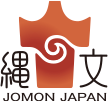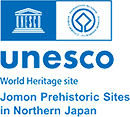About the Jomon period
The Beginning of the Jomon Period
The end of the Ice Age coincided with the closure of the Paleolithic era, when stone tools were used as main instruments, and thus the Jomon period began approximately 13,000 BCE.
As climatic warming rapidly progressed, deciduous broad-leaved forests with acorn, chestnut and walnut trees became widespread, and sediment deposition due to a rise in the sea level and rainfall formed a terrain and environment that would nurture fish and shellfish.
The Creation of Pottery, Bows and Arrows
Pottery was created just as the Jomon period began.
People of the Jomon period kneaded clay to create pottery in shapes they liked and they learned to make strong containers through chemical changes by applying heat. Such containers made it possible to boil and store food. People were now able to utilize natural resources more widely by boiling ingredients, enabling them to soften tough ingredients and remove the bitter taste of plants in this way. The creation of pottery stabilized the diet of the people.
Transition of Jomon pottery
Jomon pottery continued to be produced for approximately 10,000 years, but different characteristics can be seen depending on the time and region.
| Incipient Jomon |
The earliest pottery was plain. It was followed by ridge-patterned pottery and nail-impressed pottery, and pottery with many cord impressions. These were created approximately 10,000 years ago.
 *Collection of the Aomori Prefectural Museum |
|---|---|
| Initial Jomon |
Regional differences in the shape and pattern of pottery became apparent. In the Tohoku region and the southern Hokkaido region, the pattern changed from the impressed type, shell impression and finally the cord-mark type. Most pottery had a pointed bottom.
 (Choshichiyachi Site) |
| Early Jomon |
Regional differences in the shape and pattern of pottery became more visible. In the northern Tohoku region and the southern Hokkaido region, lower layer-type cylindrical pottery with a flat bottom and various types of cord-mark patterns was made by adding fibers to the clay.
 (Sannai Maruyama Site) |
| Middle Jomon |
Pottery decorated with applique was made in various areas. In the northern Tohoku region and the southern Hokkaido region, upper layer-type cylindrical pottery with a rim shaped like four waves and clay applique on the surface was made.
 (Sannai Maruyama Site)  (Futatsumori Site)  (Goshono Site) |
| Late Jomon |
The form became diversified while a common decoration pattern spread in eastern Japan. Thinner pottery decorated with incisions and cord-mark was made.
 (Irie Site)  (Kakinoshima Site)  (Oyu Stone Circles) |
| Final Jomon |
Elaborately decorated Kamegaoka-type pottery was made in the northern Tohoku region and the southern Hokkaido region. It showed quite a contrast to the austerely decorated pottery made in western Japan.
 (Kamegaoka Burial Site) *Fuindo Collection, Aomori Prefectural Museum |
Bows and arrows were used to safely capture game from a distance. Fishing gears such as hooks and harpoons were also developed to catch fish and shellfish. In addition, dogs were kept and plants were cultivated. In the Jomon period, people obtained food mainly through gathering, fishing and hunting.
Gathering
Mountain vegetables and nuts, such as chestnuts, walnuts and Japanese horse chestnuts were an important source of food for the people at the time. Chestnuts do not have a bitter taste that has to be removed, and can be eaten without being processed. They are also suitable to be stored and preserved. Japanese horse chestnuts should be soaked in water to remove the bitter taste, and the remains of watering places for it have been found. It is thought that they also ate mushrooms as well as potatoes and other root crops. Hard nuts were used after being crushed and milled with stone pestles, grinding stones and stone plates.

(Sannai Maruyama Site)


(Sannai Maruyama Site)
Fishing
In addition to gathering shellfish at the sea and the river, people caught fish by maneuvering dugout canoes skillfully. Excavated fishhooks and harpoon heads suggest that they caught relatively large fish by line fishing and spear fishing. Stone weights are considered to have been used as fishing net sinkers for catching small fish. Jomon people had thorough knowledge about the sea, from the area close to the shore to straits, as well as the land.

(Tagoyano Site)

(Irie Site)

(Sannai Maruyama Site)
Hunting
Bows, arrows and stone spears were used for hunting. For these tools, shale and obsidian, which are suited for creating sharp blades, were used. The animals they hunted included deer, boar, and hare, which were captured using pits as well as bows and arrows. Dogs were also used for hunting.

(Odai Yamamoto Site)

(Sannai Maruyama Site)

(Sannai Maruyama Site)
The Emergence of Settlements
The transition from a mobile life to a sedentary life led to the emergence of settlements that served as a base for living. In settlements, dwellings and graves were built, and eventually regional hub settlements were also formed. Large buildings with thick pillars, mounds used as a ritual/space, and stone circles as large monuments were also constructed there.


Graves of the Jomon Period
People at that time were buried in pit graves after they passed away. Graves for adults, arranged in rows, were made in settlements in the Early to Middle Jomon period, when a sedentary lifestyle was established. There are also examples of graves that were built en bloc in the settlement center during the Late Jomon period, and graves that were independently set up away from residential areas in the Final Jomon period. Dead children were buried in pottery.


People skillfully handled dugout canoes to achieve exchanges and trade with other people living long distances away, and transported jade, asphalt and obsidian. Many clay figurines used for rituals and accessories were also made. This indicates that they had a rich spiritual world.

(Sannai Maruyama Site)

(Kitakogane Site)

(Tagoyano Site)

(Sannai Maruyama Site)

(Kakinoshima Site)

(Futatsumori Site)
Rituals and Rites
Many remains of religious and ritualistic items whose purpose has not been identified have been found, including artifacts in the shapes of people, animals, and sword-like stones. These are thought to have been used in rites for fertility and safety at hunting, memorial services for ancestors, and as prestige goods.



(Oyu Stone Circles)
Lacquerware and Wood Products
Lacquering, which had been established around the Early Jomon period, is an integrated technique that shows the advanced skills of people at that time. Chestnut trees were indispensable for the life of the people; they were not only an important source of food, but were also used as material for posts of buildings, containers, tools such as sticks for digging, and fuel.

*Fuindo Collection, Aomori Prefectural Museum

(Korekawa Site)

(Korekawa Site)
The Physical Characteristics of People in the Jomon Period
The average height of people at that time was approximately 157 cm for men and 147 cm for women. It is thought that they had a muscular build and sculptured faces with double eyelids and thick lips.
Since teeth with cavities have been found, it is thought that Jomon people ate much starchy food. A great number of whipworm parasite eggs have been unearthed, and this finding indicates that Jomon people must have suffered abdominal pain.
Deformed ankle joints have also been found, suggesting that they probably often sat down on their heels or squatted.

The Jomon Period in World History
Since the earliest known pottery, which exemplifies the beginning of the Jomon period, has been unearthed in Aomori Prefecture, it is now thought that the earliest pottery was created in the Far East of East Asia.
Rice cultivation began in the downstream basin of the Yangtze River approximately 8,000 years ago, at the time of the early Jomon period in Japan, and people started to cultivate foxtail millet, millet and other coarse cereals shortly after in northeastern China.
The Jomon period continued for approximately 10,000 years until the beginning of the Yayoi period, when full-scale rice cultivation began on the Japanese archipelago approximately 2,400 years ago.
The Jomon period continued for a very long period. It was not a stagnant or immature society, but a mature society with superior technology and rich spiritual elements. It can be said to have reached the ultimate development of a hunting and gathering culture.
Comparative chronology of the Jomon period and world history
| Age | Time division | Major developments | World developments | |
|---|---|---|---|---|
| BCE | Paleolithic period |
|
|
|
| Approx. 13,000 |
||||
| Approx. 9,000 |
Jomon Period | Incipient |
|
|
| Approx. 5,000 |
Jomon Period | Initial |
|
|
| Approx. 3,000 |
Jomon Period | Early |
|
|
| Approx. 2,000 |
Jomon Period | Middle |
|
|
| Approx. 1,000 |
Jomon Period | Late |
|
|
| Approx. 400 |
Jomon Period | Final |
|
|
| Yayoi period |
|
|
||

